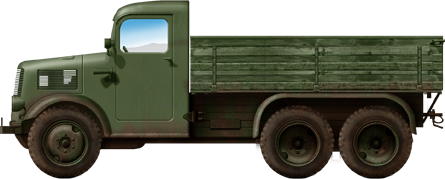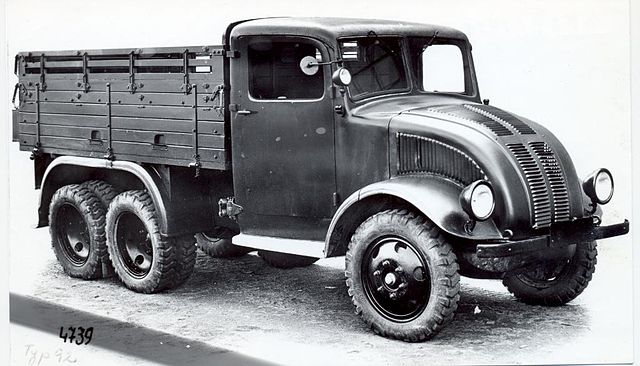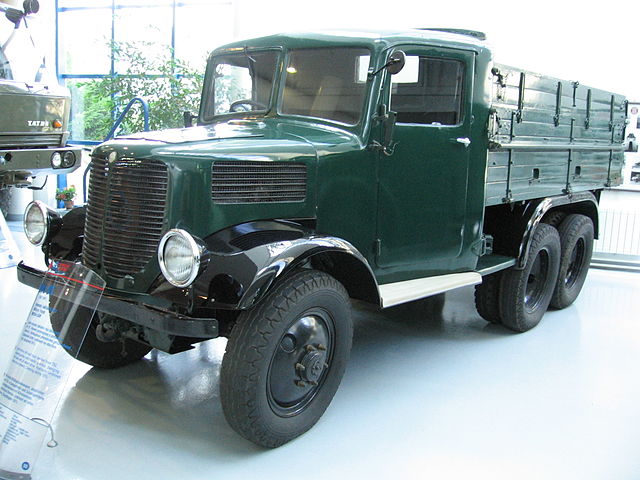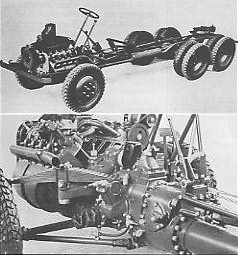Tatra 92 (1937)
 Medium 6x6 Truck (1936-1942) - 550 built
Medium 6x6 Truck (1936-1942) - 550 built

The Tatra 92 was a light military truck with 6×4 axles. It could carry 2 tons. Manufactured at Závody Ringhoffer-Tatra a.s. in Kopřivnica, only around 550 were built, a far cry compared to other Czech models such as the ubiquitous Praga RN for example (24,000 delivered). 200 were provided to the Romanian Army. All the Czech vehicles were seized by Germany ad production went on after 1938, it was also used by the Wehrmacht until 1945.
Design development 1935-37
The early origin is a MNO order for the modernization of the Tatra 82 type. With the withdrawal of the Sudetenland, the ordered vehicles were produced for the Wehrmacht which redirected almost half to the Romanian Army. In 1938–1940, apparently 529 Tatra 92 were produced and with a new front drive the type Tatra 93 was derived from it.
Design

 Early and late Tatra 92
Early and late Tatra 92
The Tatra 92 was designed as a replacement for the Tatra 82, a heavy-duty car (or light truck) produced from 1935. Mainly used by the military it was also procured as a large staff car. Its beating heart was an air-cooled OHC 4-cylinder boxer engine (2490, 55 hp) couplued with a 8/1 gearbox and weighting 3,150 kg (6,945 lb) for a 1.5 tons payload.
For the Army, Tatra was ordered to design a replacement, the same type of light off-road truck, with the same carrying capacity of 2 tons which required a new engine: It wqs a V8 rated for 74 hp, reinforced suspension on the front axle. Even before the German takeover, Romania was interested and ordered 200 from July 1937, later to receive 27 military ambulances on the same chassis.
The Tatra 92 prototype had a classic, extended flatbed and rounded hood in the style of the preceding Tatra 82. The prototype was taken over by the Czech army for field tests and gruelling trials starting on September 22, 1938. Just as the Munich crisis developed. The army was pleased by the results and subsequently placed a large order: 480 cargo trucks, with in addition 18 modified artillery trucks, 4 command vans (open vans) and one auxiliary van.
After the Munich Agreement however the entire contract was cancelled. Tatra being located on the ceded territory of the Sudetenland, the German High Command (OKH) renewed the canceled order. They also looked at the design and broughs some modifications of their own, mainly a simplification of the engine hood, which was higher and angular.
The derived Tatra 93 derived from the Tatra 92 was a true 6×6.
Engine and transmission

The Tatra 92 had a fork-mounted and air-cooled petrol engine, eight-cylinder, with OHC distribution, displacing 3981 cm³ in total, with 80 mm bore, 99 mm stroke cylinders. The max output was 54.5 kW (74 hp) at 3000 rpm. The V was angled at 90°. The compression ratio was 5.5:1. The fuel mixture went from a Solex 35 JFF double downdraft carburetor. The engine was installed longitudinally at the front, and forward of the front axle. Cooling for the engine was provided by an axial fan.
For the tranmission, the main block's Lubrication was by pressure, but there was a dry crankcase. Add to this was the dry single-disc clutch behind the engine, followed by a four-speed non-synchronized transmission, plus a two-speed reduction gearbox.
The fuel tank volume was 130 l. The electrical system was rated 12 V and there was an electric starter Bosch dynamo-accumulator for the ignition, coupled wth a 12 V dynamo rated for 130 W. It was driven by a V-belt from the camshaft.
Chassis
The chassis comprsed the classic, trademark company's steel backbone tube frame. It was equipped with a flange for the engine, and gearbox forward. The rear chassis rested on the twin drive axles, coupled with pivoting semi-axles. These rear axles were sprung by classic semi-elliptical leaf springs either side (one set above the two axles).
The non-driven front axle still was given an independent semi-axle suspension but with inclined quarter-elliptic leaf springs on either side. The front axle's wheels position was a 1,500 mm, and at the rear 1,760 mm in simple assembly, and 1,330 mm for double mounting (twin wheels). The wheelbase was 2,800+940 mm. Ground clearance was 255 mm. Being a military truck, it was also provided with a winch, with a 3000 kgs pulling force (nm.)
The braking system cmprised Lockheed liquid brakes on all wheels. The rubber wheels were of the 20-inch type (), with 5×20" pressed steel discs, 6×20" tires. They were serrated for better grip but not of the run-flat type.
Body
The Tatra 92 cabin was of a mixed construction: A wooden frame, covered with sheet metal, steel to avoid corrosion. A folding triangle was installed on the roof for signaling when towing another truck. The front window was split and equipped with two electrically powered wipers. The cabin door was a standard type, with manually cranked side windows.
Variants
Standard cargo: The Tatra's 92 flatbed was also mixed, with wooden sides reinforced b steel framing, bolted, and an optional, retractable tarpaulin with its set of frames. The rear axles had double wheel assemblies in the standard cargo configuration.
Command version: Open break-type passenger body, covered by the tarpaulin and the rear axles fitted with a simple wheel assembly.
Ambulance: Closed bodywork with a large box-type cab on the flatbed and simple wheel assembly for the rear axles.
Tatra 92 specifications |
| Dimensions | 5,945 x 2,000 x 2,610 mm |
| Weight, chassis | 1,800 kg |
| Weight, gross | 5,580 kg |
| Payload | 2,000 kg |
| Crew | 1 driver, optional co-driver. If troops carried: 12-14 |
| Propulsion | Tatra V8 OHC 4L 54.5 kW (74 hp) at 3000 rpm |
| Transmission | 4-speed non-synchronized, 2 red. Grbx |
| Top speed | 65 km/h () |
| Fuel consumption | 32–35 l/100 km |
| Climb rate | 55% |
| Suspension | Leaf springs |
| Maximum range (on/off road) | 300/150 km (190/93 mi) |
| Armament | None |
| Armor | None |
| Production | Tatra only 1938–1940 - 550+ |
The Tatra 92 in action
 Tatra 92 and captured ZiS-5 in German use
Tatra 92 and captured ZiS-5 in German use
With the early supervision of the manufacturing at Tatra, the truck was really tailored to German needs. It was used as such, in its cargo version, but also ambulance, command vehicle, and the "utility box" was tailored for the vehicle to be used as a kitchen lorry which was one of the preferred variant by the Wehrmacht. The off-road performances were limited though, and they had issues with the rasputitsa on the eastern front just as most military trucks.
The Romanian Army was the second largest user of the type, and it was largely used in its ambulance and cargo/troop carrier also on the eastern front, southern front around Stalingrad to be exact. Most were lost during the withdrawal of 1943. No data or photo shows any adaptation of the vehicle to carry an active military payload such as an AA gun. With just two tons of useful payload, it restricted possibilities.